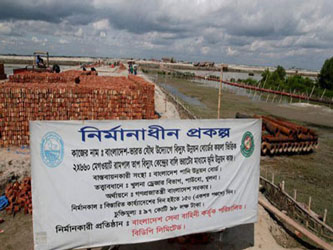
Rampal controversies: Onus lies with the government to dispel doubts
Saleh Akram | Tuesday, 8 November 2016

The Rampal Power Plant has kicked off lot of controversies in society. Environmentalist groups and some political parties are opposing the project and organising demonstrations as mark of their protest.
The proposed 1320-megawatt coal-fired power plant under a joint partnership between India and Bangladesh will be built at Rampal only 14 kilometres north of the ecologically sensitive and the largest mangrove forest of the world, the Sundarbans.
The environmentalists opposing the plant have the following arguments in support of their demands:
Firstly, the coal-fired plant will require 4.72 million tons of coal annually which will be imported from India and carried by ships to the site. The coal-carrying vehicles will scatter large amounts of fly ash, coal dust and sulfur, and release other toxic chemicals like carbon monoxide, oxides of nitrogen and sulphur dioxide around the 40 km way and put the surrounding areas and, most importantly, the Sundarbans under risk.
Secondly, the project is designed to be located at a distance of only 14 kilometres from the Sundarbans which is below the permissible limit. The environmentalists maintain that the plant might become the biggest Power Plant, but it would cost the world its largest mangrove forest. Thirdly, the project violates the environmental impact assessment guidelines for coal-based thermal power plants.
Fourthly, environmental activists contend that the proposed location of the plant would violate provisions of the Ramsar Convention to which Bangladesh is a signatory. It is an international environmental treaty for the conservation of wetlands and the Sundarbans is on Ramsar's list of wetlands of international importance.
Fifthly, according to media reports, in last few years proposals to set up similar coal-fired thermal power plants by the proposed builder National Thermal Power Corporation (NTPC) of India were rejected by India's central and state authorities. NTPC failed to obtain approval of the Indian Central Green Panel (Green Tribunal) in 2010 for the construction of coal-fired thermal power plants.
In addition, electricity produced from this plant is going to cost the consumers more than the existing price. The government of Bangladesh rejects the allegations that the coal-based power plant would adversely affect the world's largest mangrove forest. Tawfiq-e-Elahi Chowdhury, energy adviser to the Prime Minister, said that the plant will not negatively affect the mangrove forest because the emission of green house gas will be kept at the minimum level by importing high quality coal, installing a 275-meter high chimney and applying state-of-the art technology to keep its impact on the Sundarbans to a negligible level.
The environmentalists maintain that Sundarbans is not only the world's largest mangrove forest, it also protects people and resources from natural calamities. Damages inflicted by natural calamities over the years would have been higher had Sundarbans not been there. Sundarbans has a unique bio-diversity comparable only to Amazon and Florida. It is the home of about 300 rare plants, 400 varieties of fish, 270 types of birds and 42 kinds of mammals. All these not only control our climate but also influence the world climate. If the necessity for sustaining bio-diversity of the forest is overlooked, all these plants and animals shall extinct.
The Department of Energy in 2013 mentioned that the plant should be located at least 25 kilometres away from the environmentally sensitive area of the Sunderbans. The recommendation was not included in the project proposal which was also a violation of the conditions laid down in Ramsar Convention to which Bangladesh is a signatory. If the Sundarbans is affected, Bangladesh is going to lose much of its tourist attraction also.
All these facts have evoked fears in our minds on one hand and thrown us in a whirlpool of confusions on the other. People wonder what future really has in its store for us. Are the environmentalists overreacting at the probable impacts of the plant, or is the government overzealous with the economic benefit of the plant at the cost of the mangrove forest? Or is the Rampal issue fast developing into a war of attrition between the government and the environmentalists? All said and done, the onus is with the government to dispel the doubts and remove the confusions about the 'so-called' controversial project.
[email protected]